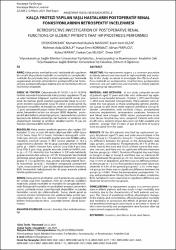KALÇA PROTEZİ YAPILAN YAŞLI HASTALARIN POSTOPERATİF RENAL FONKSİYONLARININ RETROSPEKTİF İNCELENMESİ

View/
Access
info:eu-repo/semantics/openAccessDate
2021Author
Doğan Bakı, ElifMazlum, Muhammed Mustafa
Uçan, Ecem İrem
Gökalp, Mehmet Arda
Korkmaz, Harun Emre
Parpucu, Alihan
Yaprak, Kübra
Yelken, Furkan Can
Sert, Ömer
Metadata
Show full item recordCitation
BAKI, E. D., MAZLUM, M., Ecem, U. Ç. A. N., GÖKALP, M., KORKMAZ, H., PARPUCU, A., ... & Ömer, S. E. R. T. (2021). KALÇA PROTEZİ YAPILAN YAŞLI HASTALARIN POSTOPERATİF RENAL FONKSİYONLARININ RETROSPEKTİF İNCELENMESİ. Kocatepe Tıp Dergisi, 22(3), 208-212.Abstract
AMAÇ: Kalça protez ameliyatları yaşlı hastalarda sık uygulanan
bir cerrahi olup yüksek morbidite ve mortalite ile sonuçlanabilmektedir. Bu çalışmada, kalça protezi yapılacak yaşlı hastalarda
uygulanacak anestezi yöntemlerinin postoperatif renal fonksiyonlara, postoperatif yoğun bakıma giriş ve mortaliteye etkisini
incelemeyi amaçladık.
GEREÇ VE YÖNTEM: Çalışmamızda 01.10.2013 ve 01.10.2018
tarihleri arasında hastanemizde kalça protezi uygulanan 75 yaş
ve üzeri hastaların bilgisayar kayıtları retrospektif olarak incelendi. Bu hastalar genel anestezi uygulananlar (Grup G) ve rejyonel anestezi uygulananlar (Grup R) olarak 2 gruba ayrıldı. Bu
hastaların cinsiyetleri, ek hastalıkları, erken dönem mortaliteleri
(7 gün), postoperatif yoğun bakım ihtiyaçları, perioperatif kreatinin, hematokrit ve kan üre nitrojeni (BUN) değerleri, postoperatif akut böbrek yetmezliği gelişimi, hastanede kalış süreleri
karşılaştırıldı. Böbrek yetmezliği olan hastalar ve verilerine tam
ulaşılamayan hastalar ve ameliyat oldukları tarihte 75 yaş altı
hastalar çalışmaya dâhil edilmedi.
BULGULAR: Kalça protezi ameliyatı geçirmiş olan toplam 351
hastadan 75 yaş ve üzeri 68 hasta çalışmaya dahil edildi (grup
G=53 hasta, Grup R=15 hasta). Hastaların demografik verilerinde (yaş, cinsiyet, ek hastalık) gruplar arasında farklılık yoktu.
Hastaların ameliyat sonrası % 89,7 servise çıkarken % 10,3’ü
yoğun bakıma çıkmıştır, her iki grup açısından anlamlı farklılık
yoktu (p = 0,661). Hastane kalış süreleri Grup G’de 9 gün iken,
Grup R’de 8 gün olup, gruplar arasında istatiksel farklılık yoktu (p = 0,113). Mortalite tüm hastaların % 5,9’unda belirlendi,
gruplar arasında fark yoktu (p = 0,115). Postoperatif akut böbrek
yetmezliği genel grupta % 9.4 oranında gözlenirken, rejyonel
grupta % 13,3 gözlenmiş olup, gruplar arasında anlamlı farklılık bulunmadı (p=0,661). Hastaların preoperatif, postoperatif
1.gün, ve postoperatif 7.gün biyokimyasal değerlere (kreatinin,
BUN, hematokrit) baktığımızda her iki grup arasında anlamlı
farklılık gözlenmemiştir.
SONUÇ: Kalça protez ameliyatları yaşlı hastalarda sık uygulanan
bir cerrahi olup hem hastaların, hem de cerrahinin özellikleri
nedeniyle, yüksek morbidite ve mortalite ile sonuçlanabilmektedir. Perioperatif mortalite ve morbiditeyi anestezi yönteminin
seçimi, yaşlılarda ortaya çıkan fizyolojik değişiklikler ve yandaş
hastalıklar, cerrahi tipi etkilemektedir. Sonuç olarak genel ve
rejyonel anestezi tekniklerinin ileri yaşlıların kalça protez operasyonlarından sonra kısa dönem mortalite ve postoperatif
böbrek fonksiyonlarına etkisi açısından benzer olarak bulunmuştur. OBJECTIVE: Hip replacement surgery is a common procedure
in elderly patients and may result in high morbidity and mortality. In this study, we aimed to investigate the e ects of anesthesia methods on postoperative renal function, postoperative
intensive care unit admission and mortality in elderly patients
undergoing hip replacement.
MATERIAL AND METHODS: In our study, computer records
of patients aged 75 years and older who underwent hip replacement in our hospital between October 1, 2013 and October
1, 2018 were reviewed retrospectively. These patients were divided into two groups as those undergoing general anesthesia (Group G) and those under regional anesthesia (Group R).
Gender, comorbidities, early mortality (7days), postoperative
intensive requirements, perioperative creatinine, hematocrit
and blood urea nitrogen (BUN) values, postoperative acute
renal failure, hospital stay were compared. Patients with renal
insu iciency, patients whose data were not fully available and
patients younger than 75 years of age at the time of surgery
were excluded from the study.
RESULTS: Of the 351 patients who had hip replacement surgery, 68 patients aged 75 years and older were included in the
study (Group G = 53 patients, Group R = 15 patients). There was
no di erence between the groups in the demographic data
(age, gender, comorbidity). Postoperatively, 89.7 % of the patients went to the ward and 10.3% of them went to the intensive care unit, and there was no significant di erence between
the two groups (p = 0.661). Duration of hospital stay was 9 days
in Group G, 8 days in Group R, and there was no statistical difference between the groups (p = 0.153). Mortality was determined in 5.9 % of all patients, and there was no di erence between the groups (p = 0.115). Postoperative acute renal failure was
observed in 9.4% of the general group and 13.3% in the regional group, but there was no significant di erence between the
groups (p = 0.661). When the preoperative, postoperative 1stday, and postoperative 7th-day biochemical values (creatinine,
BUN, hematocrit) were examined, no significant di erence was
observed between the two groups.
CONCLUSIONS: Hip replacement surgery is a common procedure in elderly patients and may result in high morbidity and
mortality due to the characteristics of both patients and surgery. The choice of anesthesia method, physiological changes
in the elderly, and comorbidities a ect perioperative mortality
and morbidity. In conclusion, the e ects of general and regional anesthesia techniques were found to be similar in terms of
short-term mortality and postoperative renal function after hip
replacement surgery in the elderly.















